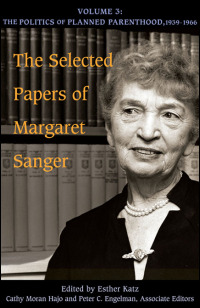The current debate over the mandate for employers to cover contraception in health
insurance plans harks back to earlier confrontations between the Catholic Church and family planning advocates. From the early 1920s until the early 1960s, Margaret Sanger was usually in the middle of this debate, countering Catholic pronouncements on the
immorality of birth control and baiting the Church into creating public controversies that ultimately advertised her cause.
 The three published volumes of The Selected Papers of Margaret Sanger, Vol. 1: The Woman Rebel, 1900-1928 (2003), Vol. 2: Birth Control Comes of Age, 1928-1939 (2006), and Vol. 3: The Politics of Planned Parenthood, 1939-1966 (2010), provide an unparalleled documentary resource on the battles between the Church and the birth control movement in the first half of the twentieth century.
The three published volumes of The Selected Papers of Margaret Sanger, Vol. 1: The Woman Rebel, 1900-1928 (2003), Vol. 2: Birth Control Comes of Age, 1928-1939 (2006), and Vol. 3: The Politics of Planned Parenthood, 1939-1966 (2010), provide an unparalleled documentary resource on the battles between the Church and the birth control movement in the first half of the twentieth century.
Volume 1 highlights the Town Hall Raid, one of the pivotal events in the history of the birth control movement and the first major public confrontation between Sanger and the Church. In November 1921, Catholic Archbishop Patrick Hayes exerted his influence over the city government and convinced the police to shut down the concluding session of the First American Birth Control Conference. Police stormed into the Town Hall theater and arrested Sanger and another activist before the meeting began. Hayes told Catholics to “stop your ears to that pagan philosophy” as he defended the police action to stem the tide of an immoral practice.
The raid and arrests provided Sanger nationwide publicity and prompted an immediate show of support from women’s groups, the professional class and many younger Americans. And it gave Sanger a public forum to respond to Church teaching. She told reporters that she had no objection to the Church telling its parishioners what to believe, but when they attempt to “force their opinions and code of morals upon the Protestant members of this country, then we do consider this an interference with the principles of this Democracy and we have a right to protest.” (Volume 1, pp. 334-335.)
 When Catholic pressure succeeded in prompting police to arrest doctors and nurses in
When Catholic pressure succeeded in prompting police to arrest doctors and nurses in
a 1929 raid of Sanger’s New York clinic, featured in Volume 2, Sanger and her attorneys framed the incident as an assault on medical privacy and women’s health care. By calling forth several of the most prominent physicians of the day to defend the use of contraception for child spacing and as preventive medicine, Sanger defined the terms of a debate that has reemerged today.
Also included in Volume 2 is coverage of Sanger’s testimony before several Congressional committees in support of bills to remove the legal barriers to birth control. She was challenged not only by Catholic congressmen, who accused her of defying God and interfering with nature, but several heavy hitters in the Church, including Father Charles Coughlin, the popular radio priest, who reminded the House Judiciary Committee of God’s command to “increase and multiply.” Sanger responded by pointing out that celibate priests might not be the best sources of advice on procreation and parenthood. In earlier testimony she snapped back against Catholic advocacy of large families by noting that Jesus was an only child. And each time this debate went public, Sanger spoke movingly of the large number of Catholic women who came to her New York clinic or who wrote to her for contraceptive information. “I have myself had,” she said, “the most pathetic cases of Catholic women torn by their loyalty to the church and their desires to control the size of the family.” (Volume 2, p. 253.)
 Maybe the closest episode to the current one occurred in 1958 when the New York City Hospital Commissioner enforced an unwritten policy prohibiting doctors from prescribing contraception in municipal hospitals. He refused to allow a Brooklyn doctor to fit a diaphragm for a woman who had been hospitalized for diabetes. The battle that ensued is well documented in Volume 3. Catholic groups praised the decision as a victory for religious freedom. Sanger and Planned Parenthood adroitly turned to the press and fed reporters enough material to keep the issue on the front pages for several weeks. Before long, a coalition of medical, civic and religious groups came together to protest the commissioner’s decision. Public pressure mounted and forced the political leadership to rescind the policy.
Maybe the closest episode to the current one occurred in 1958 when the New York City Hospital Commissioner enforced an unwritten policy prohibiting doctors from prescribing contraception in municipal hospitals. He refused to allow a Brooklyn doctor to fit a diaphragm for a woman who had been hospitalized for diabetes. The battle that ensued is well documented in Volume 3. Catholic groups praised the decision as a victory for religious freedom. Sanger and Planned Parenthood adroitly turned to the press and fed reporters enough material to keep the issue on the front pages for several weeks. Before long, a coalition of medical, civic and religious groups came together to protest the commissioner’s decision. Public pressure mounted and forced the political leadership to rescind the policy.
What Sanger said then still applies today, and to insurance coverage as well as medical
treatment: “The patient should be allowed to decide whether prescribed Medical treatment is in conformity with his or her religion.” (Volume 3, 445.)
*****
Peter C. Engelman is an associate editor of the Margaret Sanger Papers Project, a freelance writer, and an archivist.
